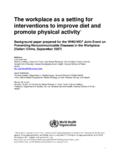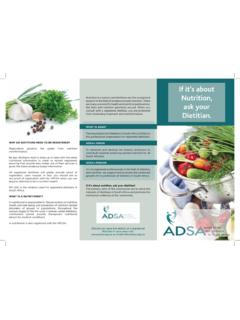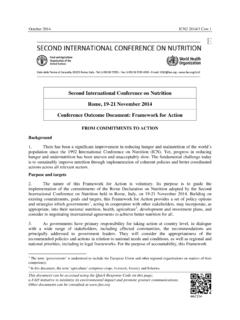Transcription of Good Practice Appraisal Tool - euro.who.int
1 1for obesity prevention programmes, projects, initiatives and interventionsWHO/EC Project on monitoring progress on improving nutrition and physical activity and preventing obesity in the European UnionGood Practice Appraisal Tool2 EUR/10/ EUDHP1003966/ 3 ABSTRACTThe World Health Organization Regional Office for Europe and the Directorate-General for Health and Consumers of the European Commission have established a joint three-year project to monitor progress in improving nutrition and physical activity and preventing obesity in the European Union. As part of this project, a good Practice Appraisal tool was developed to assess good Practice elements of design, monitoring, evaluation and implementation of preventive programmes, projects, initiatives and interventions that aim to counteract obesity and improve nutrition and physical activity.
2 This report gives a description of the good Practice tool for obesity prevention programmes and describes its development and GUIDELINESOBESITY - prevention and controlPROGRAM EVALUATION - methodsEUROPEA ddress requests about publications of the WHO Regional Office for Europe to: Publications WHO Regional Office for Europe Scherfigsvej 8 DK-2100 Copenhagen , DenmarkAlternatively, complete an online request form for documentation, health information, or for permission to quote or translate, on the Regional Office web site ( ). World Health Organization 2011 All rights reserved. The Regional Office for Europe of the World Health Organization welcomes requests for permission to reproduce or translate its publications, in part or in designations employed and the presentation of the material in this publication do not imply the expression of any opinion whatsoever on the part of the World Health Organization concerning the legal status of any country, territory, city or area or of its authorities, or concerning the delimitation of its frontiers or boundaries.
3 Dotted lines on maps represent approximate border lines for which there may not yet be full mention of specific companies or of certain manufacturers products does not imply that they are endorsed or recommended by the World Health Organization in preference to others of a similar nature that are not mentioned. Errors and omissions excepted, the names of proprietary products are distinguished by initial capital reasonable precautions have been taken by the World Health Organization to verify the information contained in this publication. However, the published material is being distributed without warranty of any kind, either express or implied.
4 The responsibility for the interpretation and use of the material lies with the reader. In no event shall the World Health Organization be liable for damages arising from its use. The views expressed by authors, editors, or expert groups do not necessarily represent the decisions or the stated policy of the World Health responsibility for the content of this report lies with the authors, and the content does not represent the views of the European Commission; nor is the Commission responsible for any use that may be made of the information contained of ContentsList of Abbreviations ..4 Acknowledgements ..4 Introduction ..4 Background.
5 4 Aim of the tool ..5 Development of the tool ..5 The tool components ..5 Scoring of good Practice ..6 Assessment of programmes ..6 Questionnaire to gather information on obesity prevention programmes ..7 Appraisal form a checklist for reviewers ..17 References ..224 List of abbreviationsThe following abbreviations are used in this disability-adjusted life yearsDG SANCO Directorate-General for Health and Consumers (EC)EC European CommissionEPODE Ensemble pr venons l ob sit des enfants (Together let s prevent childhood obesity)EU European UnionNOPA nutrition , Obesity and Physical Activity (database)QALY quality-adjusted life yearsRIVM Dutch National Institute for Public Health and the EnvironmentWHO World Health OrganizationAcknowledgementsThis document is a deliverable of work package 3 of the three-year collaborative project between the World Health Organization (WHO)
6 And the Directorate-General for Health and Consumers (DG SANCO) of the European Commission (EC), which began in January 2008 (2007 WHO02) under the title Monitoring progress on improving nutrition and physical activity and preventing obesity in the European Union (EU) . A draft of the tool was discussed at a meeting on community initiatives to improve nutrition and physical activity, convened on 21 22 February 2008 in Berlin, Germany. WHO would like to express sincere appreciation to the participants of this workshop for their valuable contributions. WHO also wishes to thank the programmes stakeholders that took part in the pilot testing rounds of the tool.
7 WHO is most grateful to the experts that pilot tested the Appraisal component of the tool to evaluate the good Practice elements of the programmes: Wanda Bemelmans, Roos Gun, Tim Lobstein, Susanne L gstrup, Alessanra Suglia and Joop van Raaij. Special thanks are due to the members of the project s Advisory Group (Michele Cecchini, Barbara Legowski and Jean-Michel Oppert) for critically reviewing the tool and to the Dutch National Institute for Public Health and the Environment (RIVM) for its technical input throughout the development of the tool. Grateful thanks are extended to Katerina Vrtikapa, former intern at the WHO Regional Office for Europe, Copenhagen and Sonja Kahlmeier, Institute for Social and Preventive Medicine, Zurich for their technical input to the development of the tool; to Lideke Middelbeek, WHO Regional Office for Europe, Copenhagen for refinement of the tool and for writing this document; to Trudy Wijnhoven, WHO Regional Office for Europe, Copenhagen for her technical input and overall coordination; to Philippe Roux, DG SANCO, Luxembourg City for his feedback.
8 And to Frank Theakston for the text three-year joint WHO/EC DG SANCO project covering the period 2008 2010, entitled Monitoring progress on improving nutrition and physical activity and preventing obesity in the EU was established to evaluate the status of country development and implementation of policies and actions in the area of nutrition , physical activity and obesity prevention. The main outcome of the project is a database on these areas (the NOPA database), which includes surveillance data, country policy documents, policy implementation tools and information on good practices. Work package of this project concerns the collection of existing public health programmes, projects, initiatives and interventions1 designed to improve nutrition and physical activity or prevent obesity of the general population.
9 Another important component is the development of a good Practice Appraisal tool to review and assess the quality of the identified programmes by independent experts. Both a summary of the programmes and an indication of good Practice will be made available through the NOPA database. This report describes the development of the Appraisal tool, presents its three components and gives instructions on how the Regional Office will use it. BackgroundOverweight and obesity are serious public health challenges in the WHO European Region (1). Many local and national programmes aim at counteracting the increasing obesity levels by promoting healthy eating and physical activity (2).
10 Some of these programmes have shown to be more successful than others in preventing obesity and thus can serve as good examples for programme planners and decision-makers in order to facilitate their choice of interventions to adopt. To identify good Practice , a tool has been developed to evaluate good Practice elements of the planning, monitoring, evaluation and implementation of programmes that can target children, adolescents or adults as well as be nationally, regionally or locally initiated in community, school or workplace settings. 1 Hereinafter, the term programmes refers to programmes, projects, initiatives and of the toolThe purpose of the tool is to systematically assess the quality of programmes.

















